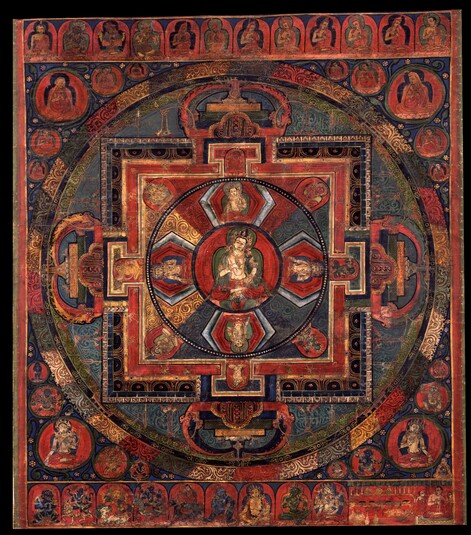
Item: Mandala of Vajrapani (Bodhisattva & Buddhist Deity) - (Sarvadurgati Tantra, Chitta)
| Origin Location | Western Tibet |
|---|---|
| Date Range | 1400 - 1499 |
| Lineages | Sakya |
| Size | 38.10x43.82cm (15x17.25in) |
| Material | Ground Mineral Pigment on Cotton |
| Collection | Rubin Museum of Art |
| Catalogue # | acc.# P1998.23.23 |
Classification: Deity
Appearance: Peaceful
Gender: Male
Vajrapani Chitta Mandala (Tibetan: chag na dor je tug kyi kyil khor, English: the Mandala of the Mind, Vajra-sceptre Holder) from the Sarvadurgati Parishodhana Tantra, with lineage teachers above and deities below.

Sanskrit: Vajrapani Tibetan: chag na dor je
Tibetan: chag na dor je
At the center of the complex circle is Vajrapani, peaceful, white in colour, with one face and two hands. The right hand holds to the heart an upright gold vajra and the left a bell turned up at the hip. Adorned with a crown of gold, earrings, necklaces, bracelets and the like, he wears green and red garments of silk. With the legs in vajra posture, he sits atop a multi-coloured lotus, surrounded by a green nimbus and areola.
Four buddhas surround the central figure. In the eastern direction, below, against a blue background is Akshobhya. At the left on a yellow background, south, is Ratnasambhava. At the top on a red background, west, is Amitabha. At the right on a green background, north, is Amoghasiddhi. Each has one face and two hands adorned with the ornaments and vestments of a youthful sambhogakaya buddha. The right hands perform the mudras (gesture) of generosity and the left held to the heart in the mudra of blessing; seated in vajra posture. In the intermediate directions are the 4 offering goddesses, white Dhupa, yellow Pushpa, red Dipa and green Gandha.
Surrounding all of that are the five coloured walls of the mandala palace with the 'T' shaped structures representing the doors, topped with 4 steps, red, blue, green and yellow. The 4 female Door Guardians sit at the entrances, white Vajrankushi, yellow Vajrapashi, red Vajrasphota and green Vajraghanta. The tips of a giant double vajra extend out from each door representing a vajra ground below the palace. An inner ring of gold vajras and an outer ring of pristine awareness fire in five colours surround the entire mandala.
Along the top is the lineage of the Maha Vairochana Sarvadurgati Tantra. Starting at the left is the buddha Vairochana, Vajrapani, king Indrabhuti, the younger king Indrabhuti, Acharya Nagarjuna, Nagabodhi, Jnanavajra, Oddiyana Anandagarbha, Rabjor Shenyen, Padmakara Varman, the great translator Rinchen Zangpo and the younger translator Legshe. At the lower top left and right are various seated lama figures, all wearing monastic robes.
At the lower left side is white Tara and above is a wrathful three faced six-armed deity. Above that is a wrathful female Krodha Bhurkumkhuta holding a vase. At the side is yellow Parnashavari and a wrathful blue figure with one face and two hands. At the lower right is a yellow male bodhisattva like figure performing the mudra of blessing with the right hand and the left in the mudra of generosity with a stream of light extending from the palm nourishing the mouth of the patron below. Above is white Achala, holding a sword, lasso and seated in a kneeling posture. Above that is a small figure of red buddha Amitayus. At the side is blue Bhutadamara Vajrapani with one face and four hands and white Mahapratisara, female, holding a sword and wheel.
Along the bottom, starting at the left are the protectors Panjarnata Mahakala, Shri Devi, Vaishravana, another Shri Devi type figure and a Tibetan local protector - female and riding a black yak. Then follow the two wealth deities black Jambhala - standing, naked, holding a skullcup and mongoose and yellow Jambhala, seated, with the mudra of generosity and the left hand holding a mongoose. Then follow the deities green Vajravidarana, for removing pernicious impurities, with one face and two hands holding a visvavajra and bell, and white Ushnishavijaya, for long-life, with three faces and eight hands.
At the bottom right an elaborate array of offerings, torma, food, water and the like are presented on tiered levels. A monastic figure sits at the side with the hands performing the mudra of Dharma teaching at the heart, attended upon by two standing monks.
Chitta Vajrapani is one of a set of 12 mandalas arising from the Sarvadurgati Parishodhana Tantra (Eliminating All Bad Rebirths) and classified as Yoga Tantra. See the Four Great Kings from the same series.
Jeff Watt 9-99
Mandala: Mandala Main Page
Tradition: Sakya Deity Paintings
Painting Style: Western Tibetan
Collection of Rubin Museum of Art: Painting Gallery 8
Buddhist Deity: Vajrapani Main Page
Mandalas: Sakya Tradition
Buddhist Deity: Sarvavid, Parishodhana Tantra Mandala List
Buddhist Deity: Vajrapani (Peaceful Iconic Figures)
Painting Style: Ngor Mandalas
Collection of Rubin Museum of Art: Mandala
Subject: Iconographic Bodhisattva
Buddhist Deity: Vajrapani Mandalas
Buddhist Deity: Vajrapani, Peaceful, Main Page
Subject: Lineage Paintings - Linear
Buddhist Deity: Vajrapani (peaceful, vajra & bell)
Buddhist Deity: Vajrapani, Mind (Sarvadurgati Tantra)
Buddhist Deity: Sarvadurgati Tantra Mandalas (Masterworks)
Subject: Confusions (Vajrasattva & Vajrapani)
Buddhist Deity: Sarvavid (Vajrapani Mandalas)
